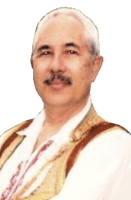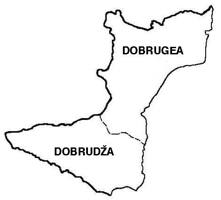
|
The Society of Folk Dance Historians (SFDH)
Dobrudžan Dances
[
Home |
About |
Encyclopedia | CLICK AN IMAGE TO ENLARGE |

|
 No other style of dance in Bulgaria is as distinctive as the Dobrudžan. Even the Šop style is not as unique or as different and difficult to master. The dances may not be anywhere as numerous as in other regions of Bulgaria and most of the movements and step patterns are also found elsewhere, but the Dobrudžan style makes them special.
No other style of dance in Bulgaria is as distinctive as the Dobrudžan. Even the Šop style is not as unique or as different and difficult to master. The dances may not be anywhere as numerous as in other regions of Bulgaria and most of the movements and step patterns are also found elsewhere, but the Dobrudžan style makes them special.
The region itself is special. Named after the city of Dobrič, now called Tolbuhin, part of Dobrudža is Bulgarian and part is Romanian. The Bulgarian section is bounded on the east by the Black Sea; the north by the Danube River and Romanian border; to the south by the line through Varna-Profidija-Šumen; the west through Šumen-Razgad-Ruse. It is a region of rich, black earth, where the life is very much attached to the land and where many different settlers have been attracted including Slavs, Turks, Romanians, Romanis, Vlachs, and recently, Bulgarian Thracians. All this is reflected in the dances.
Most of the dances are line dances and in 2/4 rhythm, such as the typical Rûka, Tropanka, Sborenka or Zborinka, Danets or Buenek, and Dvala Pûti (called Dort Ayak by the Turkish minority). Opas and Nareds are also common types in 6/8 rhythm. There are a few line Bulgarian Rûčenicas with Sei Sei Bob, Povlianka, and Brzaja as examples. Dances in 9/16 rhythm, such as ,Ižvurli, Kondak, and Bjagankata in 5/16 and 15/16 rhythms are also found. The dances in 11/16 and mixed meters have disappeared. There are also several solo dance types such as Rûčenik, Trunka, Kutsata, and Zaeškata.
The majority of these dances are mixed, with a few men's dances and only a couple of women's dances. They are usually done in a closed circle, semi-circle, and/or straight line. Only Danets is done in a spiral and/or led in zig-zag. For most Dobrudžan dances, the belt hold or Greek-style "W" hold is also typical. None of the dances move to the left. The tempo or speed is almost always moderate, but can be very slow or slightly fast on occasion. A characteristic feature of Dobrudžan dances is the constant alternating of calm and dynamic movement, or strong and weak figures.
There are lots of stamps, stressed steps, low lifts, men's squats, deep springing steps, and deep dips. Many of the specifically Dobrudžan movements and figures are imitations of farm tasks, reflecting the attachment of the Dobrudžan peasant to his work. The dances usually start slowly and calmly, and often with a slight sway, which is similar to another characteristic feature, the slow rocking or balancing from foot to foot, and then going into a sudden sharp step or motion.
Making this all in a unity, is style. First, the Dobrudžan dances are "heavy" and flat-footed, movement is usually low to the ground, and the legs are in a "kleknalo" position or semi-squat, exhibiting the bond of the peasant to the earth. Just as prominent, movement or action is never limited just to the legs. The body is relaxed, almost loose, and each part participates in the execution of the steps or figures. The shoulders twist, turn and shake, or move forward or backward. The torso twists, turns, and/or inclines forward and backward. The arms swing rhythmically and/or react to or mirror the figure. The hands reinforce or follow the movement of the legs. Often, motions are smooth and circular, especially touches or lifts.
Because of these traits, especially the freedom of supple movement, many Bulgarians consider Dobrudžan dances the most beautiful of all of the regions. Small wonder the Dobrudžans are proud of their dance traditions.
ACKNOWLEDGEMENT
- Professor Raina Katsarova, Stefan Vulglarov and Todor Dimitrov..
DOCUMENTS
- Bulgaria, a country.
- Dobrudža-Dobrogea, a region.
Printed in Folk Dance Scene, November 1977.
This page © 2018 by Ron Houston.
Please do not copy any part of this page without including this copyright notice.
Please do not copy small portions out of context.
Please do not copy large portions without permission from Ron Houston.